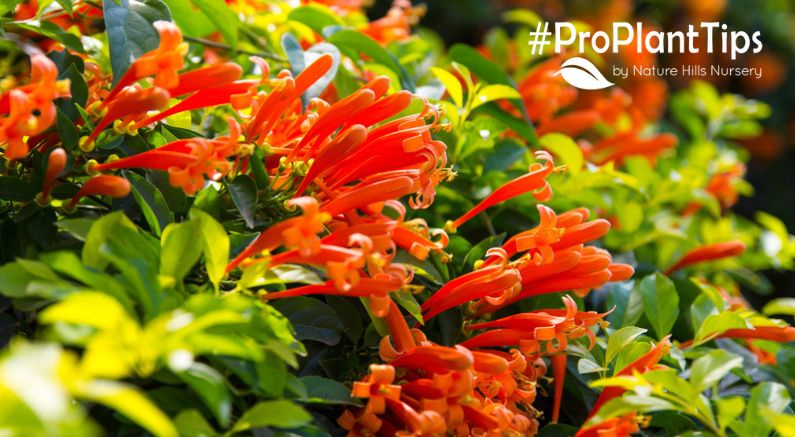The scent of heaven! Honeysuckle Vines are incredibly easy-to-grow and vibrantly flowered woody perennial Vines that make vertical gardening a snap! Their vibrant colors, sweet fragrance, and unusual tubular-shaped blooms delight onlookers both young and old!
Named for how kids 'back in the day' would pluck a flower and be able to suck out the sweet honeyed nectar from the end. With all going on in today's environment, it's best to leave that nectar for the many bees, butterflies, beneficial insects, and swarms of Hummingbirds that will be ever drawn to your Vines! (But like how we’re not supposed to eat raw cookie dough … we’re sure you’ll try it at least once!)
With the fall planting season upon us, now is a great time to plant one of these remarkable and heaven-scented vines from Nature Hills Nursery today!
Planting Honeysuckle Vines Made Easy!

Growing Honeysuckle plants can be done in just about every region of the world, as there are some that grow in dry, arid areas, and others that will grow in Arctic Russia. Here in the States, Honeysuckle Vines thrive in USDA growing zones 4 and up.
- Soak container and roots until bubbles stop rising
- Dig a hole as deep and a bit wider than the container
- Unpot and loosen roots
- Place roots in the prepared hole and backfill with soil
- Water very well and tamp down to remove air pockets
- Mulch the surface
Honeysuckle can be planted from containers all season long. Once a suitable site is selected, the hole should be dug large enough for the root system to spread out - a bit wider than the container it is currently in, but at the same depth as it is currently potted. The roots should be only a few inches underneath the surface of the soil, not too deep - not too shallow.
Once in place, the plant should be watered thoroughly. Then check moisture levels using the Finger-Test method on a daily basis to see if you need to water that day or not. Apply a layer of arborist bark chips to hold in moisture and insulate the surface roots.
Basic Honeysuckle Growing Conditions & Care

It’s fall, so now and spring are optimal planting times! Plus Honeysuckle is relatively easy to care for if the proper conditions are met, and really, it’s so easy going even a newbie gardener can enjoy these beautiful blooms!
- Full Sun to Partial Sun/Shade
- Regular, Even Moisture
- Well-Drained Alkaline to Slightly Acid Soil
- Loves Mulched Beds!
Most Honeysuckle plants require full sun to flower best, however, the more sun you give other Honeysuckle, the more blooms you’ll enjoy!
Plant these Vines in an area of moist well-drained soil that's organic and enriched with plenty of humus for holding additional moisture. While Honeysuckle Vines need a decent amount of moisture in the soil to thrive, standing water will cause rot. Growing should be done in a location with a good amount of soil drainage.
The best thing you can do is site your Honeysuckle Vine where there is good air circulation and mulch the root zone to help maintain the soil moisture at more consistent levels.
Learning to Climb
When planting Honeysuckle Vines, there should be a sturdy trellis or fence for them to climb because they climb by twining. Technically known as Bines, rather than Vines, due to this climbing method, which means that they will not be able to climb a surface that does not have anything to twist or wrap themselves around.
For sheer walls and areas you want them to climb but have no footholds - secure heavy-duty twine, wire, or wire fencing to the area to give the vines something to grab hold of.

Because of this method of ascending, there is no need to worry about persistent suckers or tendrils that dig into the wood. Your fencing and your home's paint job are safe as these will not adhere to your siding like Boston Ivy or Trumpet Vines can! Without strong, suitable support, your Vine will ramble and spill all over the ground, which is great if you want a fragrant, flowering groundcover!
Train to climb up any obelisk, arbor, trellis, fence, or staircase railing you desire, so long as it is strong enough to support these plants at maturity. You may need to use soft twist-ties or soft fabric (t-shirt material works great) to secure new tendrils until they can wrap around a new wrung or foothold.
Train up a lattice wall for privacy, train up and around seating areas, on porches and patios, or even on a sunny balcony! You’ll enjoy screening and shade, plus butterflies galore! A vine climbing a staircase or a chicken wire-wrapped column of your porch looks and smells divine!
Pruning Honeysuckle Vines
Easy to grow Lonicera generally only require an early spring prune to reduce the size or change the shape. Honeysuckle Vines are vigorous, fast growers and will need some pruning every year.
Pruning is generally done in early spring or late winter, removing old and dead growth, and trimming out thick old canes. Be careful not to prune after your Vine has started leafing out in the spring and summer because Honeysuckle blooms on new growth.
Because larger, more mature plants can get so big and bushy, they may begin to overshadow their lower branches and stems. This can result in shaded-out growth at the base or interior of the plant. You can either ‘limb up’ your plants and expose the twisted woody stems, or begin a habit of thinning out the tops so that sunlight and air circulation can get to all parts of the plant.
Sweet Climbing Blooms!
Save garden space by growing vertically while perfuming your landscape with the remarkable, vivid, climbing Honeysuckle Vines from NatureHills.com today! You will be glad you included these easy-care plants in your design!
Happy Planting!



